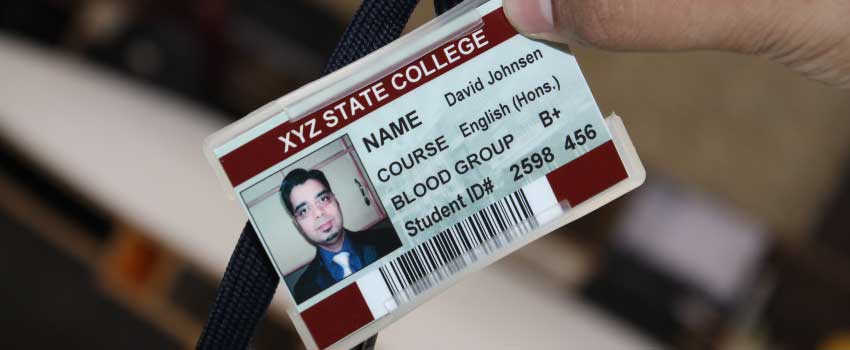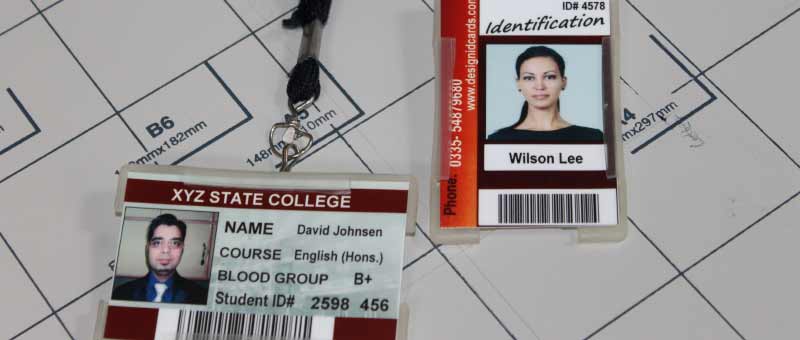Design Elements to consider when creating a Student ID Card
When creating a student ID card, there are several design elements to consider to ensure it serves its purpose effectively. Here are some key aspects to pay attention to:

- Include the official logo of the educational institution prominently on the ID card. The logo should be clear, legible, and representative of the institution's branding.
- Display the full name of the institution in a legible font to avoid confusion.
- Choose durable materials for the ID card to withstand regular use. Common choices include PVC or polycarbonate cards that are resistant to wear, tear.
- Ensure that the design of the ID card complies with any legal requirements.
- Prioritize the most important information on the card, such as the student's name and photo, by placing them prominently and ensuring they are easily identifiable at a glance.
- Use consistent typography and font sizes to establish a clear hierarchy of information. Ensure that essential details such as the student's name and ID number are easily readable.
- Ensure the design elements and information on the Student ID card are accessible to individuals with visual impairments. Consider adding braille or tactile elements if necessary.
- Include the institution's contact information, such as the main phone number or website, on the Student ID card. This allows others to easily reach out for verification or queries.
- Use a proper color scheme that aligns with the institution's branding guidelines or represents its identity clearly.
- Consider using different colors, designs to differentiate b/w different academic programs, or grade levels if necessary.
- Use high-quality graphics and ensure that all elements are sharp and easy to read.
- Use a clean and organized layout that allows for easy identification of the information on the card.
- Choose an appropriate card size and orientation (vertical or horizontal) based on the institution's requirements or standards.
- Ensure there is enough space for the required information, such as the identification details, logo, and other essential elements.
- Incorporate security features to prevent counterfeiting or unauthorized duplication of the ID card. This may include holographic overlays, microprinting, UV ink, or other anti-counterfeit measures.
- Consider adding a barcode, magnetic stripe, or smart chip to enable electronic verification or access control systems.
- Include the student's first name, last name, and possibly middle name or initial.Assign a unique identification number to each student and display it prominently on the card.
- Include a recent, clear, and recognizable photograph of the student on the card. Ensure the photo is well-lit and the student's face is visible.
Remember, the specific design elements may vary depending on the educational institution's requirements, branding guidelines, and security considerations. It is crucial to consult with relevant stakeholders, such as school administrators or design professionals, to create an ID card design that meets all the necessary criteria.
Download and Install ID Card Software
Benefits of having a well-designed Student ID Card
A well-designed student ID card offers several benefits to both the educational institution and the students themselves. Here are some of the key advantages:
Here are the steps involved in scanning an EAN13 barcode:-
01Privileges and Discounts:
Some educational institutions provide special privileges or discounts to students with valid ID cards. These benefits may include reduced ticket prices for events, discounted memberships at gyms or recreational facilities, access to student-exclusive areas, or discounts at local businesses partnered with the institution. Such perks encourage students to carry and utilize their ID cards, fostering a sense of belonging and engagement with the institution.
-
02Access to Facilities and Services:
Many educational institutions use student ID cards as access cards for various facilities and services. These may include entry to classrooms, libraries, laboratories, sports facilities, residence halls, dining areas, and transportation services. By incorporating access control technology into the ID card system, institutions can efficiently manage and control access to different areas, ensuring that only authorized students can utilize specific resources.
-
03Attendance Tracking:
Student ID cards can be equipped with barcode or RFID technology, enabling automated attendance tracking. By simply scanning or tapping the card at designated checkpoints, institutions can accurately record student attendance in classes, lectures, or other events. This simplifies administrative tasks, reduces errors, and provides valuable data for analyzing attendance patterns and identifying students who may require additional support or intervention.
-
04Financial Transactions:
A well-designed student ID card can function as a payment card within the institution. By integrating the card with a prepaid account or linking it to a student's existing financial account, it becomes a convenient and secure method for making purchases within the campus. Students can use their ID cards to buy meals in the cafeteria, pay for textbooks or other stationery items, access printing or photocopying services, and even make transactions at vending machines.
-
05Library Services:
Libraries often rely on student ID cards to manage borrowing and return processes efficiently. With a well-designed ID card, students can easily check out books, access digital resources, and avail themselves of library services. This streamlines library operations, ensures accurate tracking of borrowed materials, and enhances the overall user experience.
-
06Identification and Security:
A student ID card serves as an official form of identification for students within the institution. It provides a quick and easy way to verify a student's identity, ensuring that only authorized individuals have access to school facilities and resources. This helps maintain a safe and secure environment by reducing the risk of unauthorized entry or potential security threats.
-
07Emergency Situations:
In case of emergencies or critical situations, student ID cards can play a crucial role. The cards can be used to quickly identify students and provide necessary information to first responders. Additionally, the cards can be linked to emergency notification systems, allowing institutions to rapidly communicate important updates and safety instructions to students.
Overall, a well-designed student ID card simplifies administrative processes, enhances security, provides convenient access to facilities and services, facilitates financial transactions, and contributes to the overall student experience. By leveraging technology and thoughtful design, institutions can maximize the benefits of student ID cards and create a more efficient and engaging learning environment.
Ideal size for a Student ID Card
The ideal size for a student ID card can vary depending on the institution, region, or specific requirements. However, there are some common standards and considerations to keep in mind when determining the size of a student ID card. Here's a detailed explanation:
